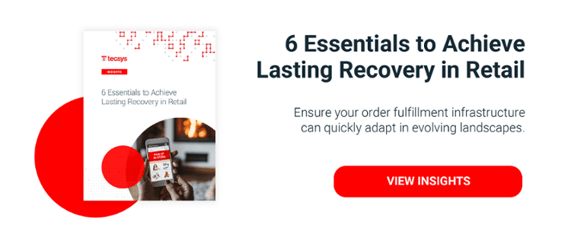What Exactly is Omnichannel Fulfillment?

Omnichannel has become more than just a buzzword in retail. Omnichannel retail is gaining momentum. So, what exactly does it mean? What specifically is omnichannel fulfillment, in the retail environment? More importantly, does it matter?
What is Omnichannel Fulfillment?
Order fulfillment happens after a customer makes a purchase. In short, it takes the customer orders (purchases) then finds, allocates, and delivers the merchandise to the shopper. Omnichannel fulfillment is the order fulfillment process completed across multiple channels. In fact, it uses the full resources at the retailer’s disposal to get the order to the customer. For example, an order can be accepted online (buy channel). It can be shipped-to-store from the warehouse (fulfillment center). Alternatively, it can be picked up in-store (brick and mortar store). There are many possibilities and permutations.
Omnichannel fulfillment is different from traditional models. The most common fulfillment model is a straight ‘order in – warehouse fulfills’ process. It is actually like having a single order management business rule. However, this is without the flexibility to optimize across other options. It might get the job done. But, it does not leverage the retailer’s full resources. Simple fulfillment is not always the best option for the merchant. In contrast, omnichannel fulfillment is about using one of a variety of order completion strategies. Specifically, it is about choosing the option that makes the most sense for that order.
Read More: Should you use a Retail Ship-from-Store to Fulfill Online Orders?
Omnichannel Fulfillment: Strategies
A few examples of omnichannel fulfillment strategies include:
- Ship-from-DC (warehouse)
- Ship-from-3PL (or manufacturer)
- Ship-from-Store
- Ship-to-Store (for In-store Pickup)
- Ship-to-Partner (pickup depot | carrier | post outlet | locker)
With this variety, the order management engine can use business rules to choose the best option. These business rules are those setup by the retailers. A retail systems admin can choose rules from a drop down menu. They can also create new business rules with easy to use boolean AND, OR, NOT commands.
A new study by Forrester and NRF shed some further light on omnichannel fulfillment. Asked about retailers top consumer-facing initiatives, 15% responded ‘ship-from-store’, with another 12% stating ‘omnichannel fulfillment’. In effect, 27% of retailers feel that omnichannel fulfillment strategies are their key concern in 2018.
Benefits of Omnichannel Fulfillment
There are many benefits to omnichannel fulfillment. First, it gives retailers a lever to help run the business. A retailer can optimize for cost reductions. For example, the OMS chooses the most cost-effective fulfillment process for each order. Alternatively, a retailer can decide that customer satisfaction is crucial. For them, speed of delivery, or delivering one single consolidated box – might be key. Either way, retail management can set the levers they want for order completion.
Second, fulfillment can improve customer satisfaction. Imagine a retailer focused on being environmentally responsible. Customers are drawn by its philosophy and brand message. As such, that retailer turns on order consolidation. This makes sure all online orders are shipped in one box with one delivery. This being from the location closest to the customer. In some cases, it may delay an order completion but it holds true to the retailer’s brand promise. Despite the delay, the greater environmental good keeps its customers happy and loyal.
Third, it improves the robustness of the retailer’s operation. Retailers using omnichannel fulfillment, use a several options to deliver goods to shoppers. If one fulfillment route fails, the operation can pivot to other options. In the winter, a serious snowstorm can completely lock in a distribution center for days. Retailers with a single ship-from-DC approach might be locked out of lucrative Black Friday orders. But, the retailer using omnichannel fulfillment can quickly change business rules. They change the fulfillment center from snowed-in DC to stores not affected by the storm. All done from drop down menus or easy boolean commands.
Related: Retail Order Management
Challenges with Omnichannel Fulfillment
Two main challenges can stand as omnichannel fulfillment barriers. First, an attitude or culture that resists change. This challenge is often best overcome with two way communication about the retailer’s vision. Help from change management experts can also be a big help. Truth is that omnichannel fulfillment needs the company to shift and to learn new methods. It isn’t just the supply chain management side for the business, either. The retailer needs to embrace change and better approaches, throughout. What results, are more robust retail capabilities. It also improves the customer experience.
Second is the choice of where to start. It is best to learn how to crawl, then stand, then walk, and only then run. Choose one omnichannel fulfillment strategy that is easiest for your people embrace. Find the one that is least disruptive. Perhaps it is already a well-known and used process. This will be an early win on which to build the team’s momentum. It also helps the organization feel that this is a challenge that has a solution.
Taking the First Steps
Between challenges and rewards, omnichannel fulfillment brings many opportunities to retailers. Despite the challenges, the reward far outweigh them. Omnichannel retailing is not going away. Rather, consumers are more aware of these new services than ever. As such, omnichannel has already become an expectation in the mind of the shopper. If your operation is not already onto omnichannel fulfillment for orders, then first make the decision to start. Remember, it isn’t just about material handling, and optimized routing. It is about adapting to a better way of doing business, overall. Take it slow, but make progress. Learn to crawl. Then don’t stop learning and adapting!




